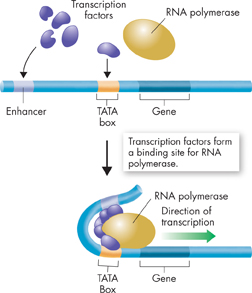Eukaryotic Gene Regulation
 How are genes regulated in eukaryotic cells?
How are genes regulated in eukaryotic cells?
The general principles of gene regulation in prokaryotes also apply to eukaryotes, although there are differences. Most eukaryotic genes are controlled individually and have more complex regulatory sequences than those of the lac repressor system.
Figure 13–17 shows several features of a typical eukaryotic gene. One of the most interesting is the TATA box, a short region of DNA, about 25 or 30 base pairs before the start of a gene, containing the sequence TATATA or TATAAA. The TATA box binds a protein that helps position RNA polymerase by marking a point just before the beginning of a gene.

FIGURE 13–17 The TATA Box and Transcription Many eukaryotic genes include a region called the TATA box that helps position RNA polymerase.
ddTranscription Factors Gene expression in eukaryotic cells can be regulated at a number of levels. One of the most critical is the level of transcription, by means of DNA-binding proteins known as transcription factors.  By binding DNA sequences in the regulatory regions of eukaryotic genes, transcription factors control the expression of those genes. Some transcription factors enhance transcription by opening up tightly packed chromatin. Others help attract RNA polymerase. Still others block access to certain genes, much like prokaryotic repressor proteins. In most cases, multiple transcription factors must bind before RNA polymerase is able to attach to the promoter region and start transcription.
By binding DNA sequences in the regulatory regions of eukaryotic genes, transcription factors control the expression of those genes. Some transcription factors enhance transcription by opening up tightly packed chromatin. Others help attract RNA polymerase. Still others block access to certain genes, much like prokaryotic repressor proteins. In most cases, multiple transcription factors must bind before RNA polymerase is able to attach to the promoter region and start transcription.
Promoters have multiple binding sites for transcription factors, each of which can influence transcription. Certain factors activate scores of genes at once, dramatically changing patterns of gene expression in the cell. Other factors form only in response to chemical signals. Steroid hormones, for example, are chemical messengers that enter cells and bind to receptor proteins. These “receptor complexes” then act as transcription factors that bind to DNA, allowing a single chemical signal to activate multiple genes. Eukaryotic gene expression can also be regulated by many other factors, including the exit of mRNA molecules from the nucleus, the stability of mRNA, and even the breakdown of a gene's protein products.
 In Your Notebook Compare gene regulation in single-cell organisms and multicellular organisms.
In Your Notebook Compare gene regulation in single-cell organisms and multicellular organisms.
MYSTERY CLUE

To make the mouse gene work inside the cells of a fly, researchers attached a new promoter sequence to the gene. Why do you think they did that?

Table of Contents
- Formulas and Equations
- Applying Formulas and Equations
- Mean, Median, and Mode
- Estimation
- Using Measurements in Calculations
- Effects of Measurement Errors
- Accuracy
- Precision
- Comparing Accuracy and Precision
- Significant Figures
- Calculating With Significant Figures
- Scientific Notation
- Calculating With Scientific Notation
- Dimensional Analysis
- Applying Dimensional Analysis




